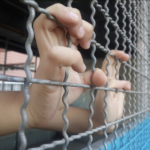There’s a Desperate Need to Focus on Rehabilitation in Australian Prisons

A new programme introduced this year at Cooma Correctional Centre in in Southern New South Wales is matching inmates with homeless, unwanted dogs, and the early results are exceptionally positive.
The programme is a collaboration between the prison and Snowy Monaro Regional Council, and provides small group of inmates the opportunity to care for dogs that would otherwise go to the pound.
In the mornings, the inmates release dogs from their cages, clean up after them, replenish their water and food, and then take them into the yard for a run. The health and welfare of the dogs are entirely their responsibility.
And the feedback from inmates has been extremely positive: reporting that building a connection with their companions has improved their mental wellbeing, reduced feelings of loneliness and, in some cases, instilled a sense of hope that perhaps one day, when they’re in the general community, could help them to move forward with a sense of responsibility.
A number have said that after that day comes, they intend to get a dog of their own.
A focus on overall ‘wellbeing’
The health benefits of dog ownership are well documented – they can provide a sense of responsibility and companionship, and of course, playing with a dog, or cuddling a dog can be excellent for lowering stress and managing anxiety, because this loving interaction boosts the ‘feel good’ chemicals in the brain – oxytocin and dopamine, creating positive feelings and a sense of bonding, for both the human and the dog.
We need more of this in Australia – programmes which have the dual benefit of fulfilling a real community need.
Last year, inmates at both Cessnock and Grafton Correctional Centres built tiny homes for flood victims, prompting many to wonder why it had to take a crisis to utilise the ‘people power’ within the prison system, and to suggest that perhaps these prison-built tiny homes might have a role to play in solving the homelessness catastrophe overall.
Projects that require release from prison grounds, like the old “chain gangs” can be controversial because of community safety concerns, but Australia definitely needs to begin thinking outside the square when it comes to helping inmates to rehabilitate inside prison walls.
Prison is the punishment, not a place to be punished
Some members of the community continue to believe the focus inside prisons should be on punishment rather than rehabilitation.
But this short-sighted populist view overlooks the fact that prison is the punishment and not a place to be further punished – in other words, the loss of liberty is the penalty for committing crimes.
Treating inmates inhumanely is not only unjust and diminishes our own claims of humanity, but is against the interests of society as a whole as it merely entrenches feelings of alienation, stigmatisation, anger and resentment – which increase the likelihood of remaining trapped in the cycle of crime once released.
Focusing on rehabilitation and reap the social benefits
In fact, other countries such as Norway have for some decades ago taken a bold approach to redeveloping their prison systems under the fundamental premise that inmates are human and should be treated with dignity and respect.
This approach has reaped dividends. Not only does Norway have one of the lowest crime rates in the world, it has one of the lowest reoffending rates.
Its prisons are secured with high wire fences, but they’re built in isolated areas – they’re light and airy, and allow for plenty of greenery, and access to the outdoors. Enabling inmates to access to fresh air, and nature, combined with a focus firmly on rehabilitation, Norway has one of the lowest crime rates in the world.
In Australia, by contrast, our prisons are overcrowded. Where there are windows, in most cases, security bars let little light in. Food is supplied as single frozen meals and reheated before serving. Prison food has been regularly criticised for not providing adequate nutritional value.
Addressing risks of re-offending
An Australian report by the Australian Institute of Criminology acknowledges the complexity of the “disadvantages confronting inmates pre- and post-release and that offenders’ issues cannot be addressed with a single general program or intervention.”
However, the benefits of a more tailored approach to address individual needs could be very widespread.
Figures from the Sentencing Advisory Council show that 42.7% of the inmates released during 2019-20, returned to corrective services in the two years to 2021-22.
The New South Wales rate was higher than the national average at 49.1%
Research conducted in the USA which focuses on the “collateral consequences” of repeated cycles of imprisonment, explains that these typically extend beyond the individual through to communities and can include stigmatisation of a particular geographic area which then has economic consequences for the entire community.
Plenty of reasons to invest in rehabilitation
So, there are important reasons to ‘invest’ in offenders beyond simply locking them up, providing basic food and medical care. And while there are innovative programmes occurring in many detention facilities, such as opportunities for study, vocational-type courses and therapies, but
these are often-short-lived, or cannot be expanded beyond pilot programmes or small trial groups because funding or the will to persevere long term dries up, or both.
We also need more programmes which address the specific cultural and social needs of indigenous people, who are over-represented in the system, across all age groups.
Another problem here in Australia is the prevalence of privately run correctional centres. When a centre is privately run that usually means that while the government retains ‘oversight’ they’re not wholly responsible for day-to-day management.
Currently in New South Wales there are 36 correctional facilities, 33 of these are run by Corrections NSW, the other three – Junee, Parklea and Grafton are run by private companies – GEO, MTC/Broadspectrum and Serco respectively.
While the issue of anyone profiting from incarceration is, in the eyes of many, completely abhorrent, there are privately run prisons all over the world nd have been for decades.
Once touted as the most ‘efficient and cost-effective way’ to run facilities because competition means that companies will often challenge each other on price for state tenders, there have been a number of very serious issues with these companies around performance, accountability, effectiveness, transparency, treatment of inmates and importantly, effort and contribution towards recidivism.
Reliable data is not easy to come by. But it doesn’t take much logic to understand that more inmates means a need for more detention centres, which means a strain on the taxpayer purse, and potentially, drives the need for privately run companies to fill the gap.
However, with recidivism rates at almost half, it’s time that it became a firm focus of our detention centres, because failing to address it means that the problem will only become bigger over time, particularly given the fact that the highest group at risk of re-offending are under 18 years of age.







